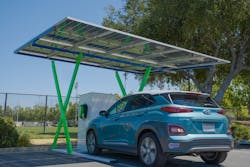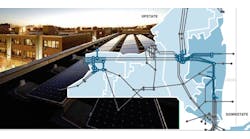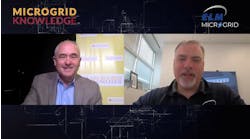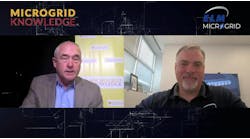In New York City, electric vehicle (EV) charger developers must wait about two years to interconnect chargers to the grid, after planning, permitting, zoning and environmental studies are completed. In California – where 25% of passenger vehicle sales are now electric — that wait time is 18 months.
But with solar microgrids, developers can deploy EV chargers in about an hour, said Desmond Wheatley, president and CEO of Beam Global, which provides solar microgrids for EV charging.
Interconnection wait times are a significant obstacle to moving the clean energy transition forward. Woody Hastings, program manager for The Climate Center, told Microgrid Knowledge, “I’ve seen reports that interconnection can take many, many years. Beyond a couple of months, people want these things interconnected when they’re ready to be connected.”
Grid limitations slow EV charging infrastructure rollouts
Electric grid limitations are the most significant roadblock to rolling out EV charging infrastructure for commercial EVs, according to Xendee. The EV charging and microgrid design services provider reached this conclusion after conducting a survey of leaders involved in the development, construction, operation or use of commercial EV charging projects.
The research found that the EV industry faces structural electric-grid-related hurdles that undermine the development and operation of EV charging infrastructure. The study concluded that microgrids can help reduce cost and grid challenges.
“The utility grid, magnificent though it is, was never built to replace diesel and gas as transportation fuel,” said Wheatley.
High growth rate for solar microgrid provider
With a handful of solar microgrid options available, evading the interconnection wait time is becoming more attractive. Beam Global, which launched in 2006 and offers solar plus its own storage systems, is seeing 300% growth year over year, said Wheatley. Startup Paired Power also provides solar microgrids for EV charging that include a pop-up solar canopy plus storage that can be deployed in about a day, said Tom McCalmont, CEO of Paired Power.
BoxPower also offers solar microgrids for EV charging.
Ballot initiative would create solar microgrids and nonutility distribution
Another attempt to leapfrog interconnection delays is an effort called the Renewable Energy Acceleration Law, which is being proposed as a California ballot initiative. It would create solar microgrids that would sell power to neighbors within a two-mile radius and transport the energy using nonutility distribution and metering systems, said Jonathan Greenberg, a creator of the initiative along with Anthony Wexler, a founder of the University of California Davis’ Air Quality Research Center. Wexler and Greenberg are trying to raise $6 million to gather the signatures needed to get the initiative on the ballot.
The solar microgrids could be used to charge EVs or for other uses.
Demand for solar microgrids from cities, military and wineries
For solar microgrid-based EV charging systems, demand is coming from a broad range of customers. Beam Global is working with New York City, which has a fleet of 36,000 vehicles, with several thousand electrified so far. “Con Edison doesn't have enough electricity for New York’s current baseload or enough for the millions of cars that visit,” said Wheatley. Beam Global provides microgrids to add capacity so Con Edison doesn’t have to build more transmission, he said.
Other customers include the U.S. Army, Johnson & Johnson and Google, he said.
Paired Power – whose standard charging unit includes 5 kW of solar and a 42-kWh battery – has 75 installations in the U.S. to date. One of its off-grid solar microgrids powers an electric, driver-optional tractor from Monarch Tractor at Kaerskov Vineyard, which is managed by Carr Winery.
With the solar microgrid, the winery has lowered its expenses on fuel and service by about 60%, according to Paired Power. The company’s charging stations can also charge a swappable battery cart during the day, providing the tractor with a full recharge for nighttime operations.
The winery project was funded in part by Santa Barbara County’s Air Pollution Control District’s Clean Air Grant and CalCom Energy – a solar energy installer.
Another customer is the Delaware National Guard. Paired Power is also looking at islands, which are good prospects because they generally have high solar potential and high electric rates.
The Paired Power system can operate off grid and grid-connected.
Lowering costs, avoiding infrastructure construction
Not only do solar microgrids leapfrog transmission hassles, according to Wheatley, but they also reduce energy costs and avoid construction of utility electrical infrastructure.
“Your unit of energy is free,” Wheatley said. “Fleet operators are fueling on just solar.”
Track news about solar microgrids and more. Subscribe to the free Microgrid Knowledge newsletter.








